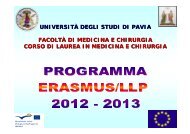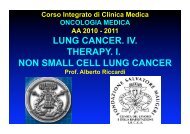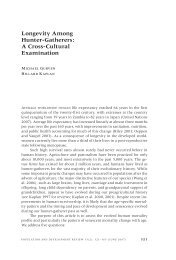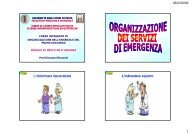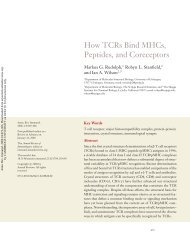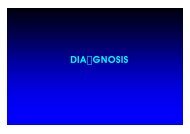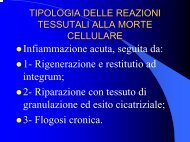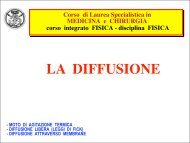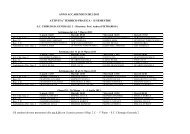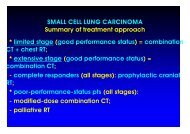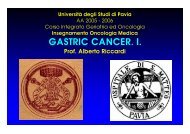Overview of CPR
Overview of CPR
Overview of CPR
You also want an ePaper? Increase the reach of your titles
YUMPU automatically turns print PDFs into web optimized ePapers that Google loves.
then return to the victim, begin the steps <strong>of</strong> <strong>CPR</strong>, and<br />
use the AED.<br />
● After delivery <strong>of</strong> 2 rescue breaths, healthcare providers<br />
should attempt to feel a pulse in the unresponsive, nonbreathing<br />
victim for no more than 10 seconds. If the<br />
provider does not definitely feel a pulse within 10 seconds,<br />
the provider should begin cycles <strong>of</strong> chest compressions and<br />
ventilations.<br />
● Healthcare providers will be taught to deliver rescue<br />
breaths without chest compressions for the victim with<br />
respiratory arrest and a perfusing rhythm (ie, pulses).<br />
Rescue breaths without chest compressions should be<br />
delivered at a rate <strong>of</strong> about 10 to 12 breaths per minute for<br />
the adult and a rate <strong>of</strong> about 12 to 20 breaths per minute for<br />
the infant and child.<br />
● Healthcare providers should deliver cycles <strong>of</strong> compressions<br />
and ventilations during <strong>CPR</strong> when there is no<br />
advanced airway (eg, endotracheal tube, laryngeal mask<br />
airway [LMA], or esophageal-tracheal combitube [Combitube])<br />
in place. Once an advanced airway is in place for<br />
infant, child, or adult victims, 2 rescuers no longer deliver<br />
“cycles” <strong>of</strong> compressions interrupted with pauses for ventilation.<br />
Instead, the compressing rescuer should deliver<br />
100 compressions per minute continuously, without pauses<br />
for ventilation. The rescuer delivering the ventilations<br />
should give 8 to 10 breaths per minute and should be<br />
careful to avoid delivering an excessive number <strong>of</strong> ventilations.<br />
The 2 rescuers should change compressor and<br />
ventilator roles approximately every 2 minutes to prevent<br />
compressor fatigue and deterioration in quality and rate <strong>of</strong><br />
chest compressions. When multiple rescuers are present,<br />
they should rotate the compressor role about every 2<br />
minutes. The switch should be accomplished as quickly as<br />
possible (ideally in less than 5 seconds) to minimize<br />
interruptions in chest compressions.<br />
Age Delineation<br />
Differences in the etiology <strong>of</strong> cardiac arrest between child<br />
and adult victims necessitate some differences in the recommended<br />
resuscitation sequence for infant and child victims<br />
compared with the sequence used for adult victims. Because<br />
there is no single anatomic or physiologic characteristic that<br />
distinguishes a “child” victim from an “adult” victim and no<br />
scientific evidence that identifies a precise age to initiate<br />
adult rather than child <strong>CPR</strong> techniques, the ECC scientists<br />
made a consensus decision for age delineation that is based<br />
largely on practical criteria and ease <strong>of</strong> teaching.<br />
In these 2005 guidelines the recommendations for newborn<br />
<strong>CPR</strong> apply to newborns in the first hours after birth until the<br />
newborn leaves the hospital. Infant <strong>CPR</strong> guidelines apply to<br />
victims less than approximately 1 year <strong>of</strong> age.<br />
Child <strong>CPR</strong> guidelines for the lay rescuer apply to children<br />
about 1 to 8 years <strong>of</strong> age, and adult guidelines for the lay<br />
rescuer apply to victims about 8 years <strong>of</strong> age and older. To<br />
simplify learning for lay rescuers retraining in <strong>CPR</strong> and AED<br />
apropos the 2005 guidelines, the same age divisions for<br />
children are used in the 2005 guidelines as in the ECC<br />
Guidelines 2000. 28<br />
Part 3: <strong>Overview</strong> <strong>of</strong> <strong>CPR</strong> IV-13<br />
Child <strong>CPR</strong> guidelines for healthcare providers apply to<br />
victims from about 1 year <strong>of</strong> age to the onset <strong>of</strong> adolescence<br />
or puberty (about 12 to 14 years <strong>of</strong> age) as defined by the<br />
presence <strong>of</strong> secondary sex characteristics. Hospitals (particularly<br />
children’s hospitals) or pediatric intensive care units<br />
may choose to extend the use <strong>of</strong> Pediatric Advanced Life<br />
Support (PALS) guidelines to pediatric patients <strong>of</strong> all ages<br />
(generally up to about 16 to 18 years <strong>of</strong> age) rather than use<br />
onset <strong>of</strong> puberty for the application <strong>of</strong> ACLS versus PALS<br />
guidelines.<br />
Use <strong>of</strong> AED and Defibrillation for the Child<br />
When treating a child found in cardiac arrest in the out-<strong>of</strong>hospital<br />
setting, lay rescuers and healthcare providers should<br />
provide about 5 cycles (about 2 minutes) <strong>of</strong> <strong>CPR</strong> before<br />
attaching an AED. This recommendation is consistent with<br />
the recommendation published in 2003. 29 As noted above,<br />
most cardiac arrests in children are not caused by ventricular<br />
arrhythmias. Immediate attachment and operation <strong>of</strong> an AED<br />
(with hands-<strong>of</strong>f time required for rhythm analysis) will delay<br />
or interrupt provision <strong>of</strong> rescue breathing and chest compressions<br />
for victims who are most likely to benefit from them.<br />
If a healthcare provider witnesses a sudden collapse <strong>of</strong> a<br />
child, the healthcare provider should use an AED as soon as<br />
it is available.<br />
There is no recommendation for or against the use <strong>of</strong> AEDs<br />
for infants (1 year <strong>of</strong> age).<br />
Rescuers should use a pediatric dose-attenuating system,<br />
when available, for children 1 to 8 years <strong>of</strong> age. These<br />
pediatric systems are designed to deliver a reduced shock<br />
dose that is appropriate for victims up to about 8 years <strong>of</strong> age<br />
(about 25 kg [55 pounds] in weight or about 127 cm [50<br />
inches] in length). A conventional AED (without pediatric<br />
attenuator system) should be used for children about 8 years<br />
<strong>of</strong> age and older (larger than about 25 kg [55 pounds] in<br />
weight or about 127 cm [50 inches] in length) and for adults.<br />
A pediatric attenuating system should not be used for victims<br />
8 years <strong>of</strong> age and older because the energy dose (ie, shock)<br />
delivered through the pediatric system is likely to be inadequate<br />
for an older child, adolescent, or adult.<br />
For in-hospital resuscitation, rescuers should begin <strong>CPR</strong><br />
immediately and use an AED or manual defibrillator as soon<br />
as it is available. If a manual defibrillator is used, a defibrillation<br />
dose <strong>of</strong> 2 J/kg is recommended for the first shock and<br />
a dose <strong>of</strong> 4 J/kg for the second and subsequent shocks.<br />
Sequence<br />
If more than one person is present at the scene <strong>of</strong> a cardiac<br />
arrest, several actions can occur simultaneously. One or more<br />
trained rescuers should remain with the victim to begin the<br />
steps <strong>of</strong> <strong>CPR</strong> while another bystander phones the emergency<br />
response system and retrieves an AED (if available). If a lone<br />
rescuer is present, then the sequences <strong>of</strong> actions described<br />
below are recommended. These sequences are described in<br />
more detail in Part 4: “Adult Basic Life Support,” Part 5:<br />
“Electrical Therapies,” and Part 11: “Pediatric Basic Life<br />
Support.”<br />
For the unresponsive adult, the lay rescuer sequence <strong>of</strong><br />
action is as follows:



